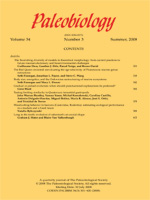The richness (number of species) and evenness (uniformity of species abundances) of death assemblages can differ from corresponding living communities due to processes such as between-habitat transport, environmental condensation, and differential taphonomic destruction. Analysis of 132 single-census live-dead comparisons of benthic molluscs from a variety of soft-bottom marine settings indicates that on average evenness does not differ greatly between live and dead assemblages, regardless of the particular depositional setting or grain size of associated sediment. However, individual death assemblages can deviate quite substantially from their corresponding living assemblages, especially if processed using a fine mesh. In addition, death assemblages collected using sieves with 2 mm mesh or coarser showed consistently and significantly greater evenness than corresponding living assemblages. These results are encouraging for broad-scale assessments of evenness in the fossil record based on the comparison of average values (rather than for individual assemblages) and where trends in evenness are the aim of the study.
Our live-dead comparisons of richness sample-size corrected by rarefaction revealed that death assemblages were on average ∼1.45 times richer than the corresponding living assemblages regardless of rarefied size. In 63.6% of death assemblages both dead richness and dead evenness were greater than live, suggesting sufficient time-averaging to catch significant random or directional changes in the living community and/or introduction of individuals from outside the sampled habitat. In 12.9% of collections both dead richness and dead evenness were less than live, suggesting either rapid loss of dead shells so that dead diversity is depressed below the local living community or selective loss of taphonomically vulnerable taxa. In 18.2% of data sets dead richness was elevated but dead evenness was depressed relative to live: these are interpreted to reflect the addition of low-evenness allochthonous material. The remaining 4.5% of data sets had elevated dead evenness but depressed dead richness, suggesting that live and dead in this case may not be closely related.
In seven available time series, temporal volatility in living communities over 6–24 months was considerable but could not account for observed (mostly higher) evenness values in corresponding death assemblages, whose evenness and composition were quite stable in the few examined studies. A densely sampled spatial transect shows that changes in living-assemblage evenness along an environmental gradient were preserved in the corresponding death assemblages, although dead evenness at any location on the gradient was substantially higher than living evenness.





